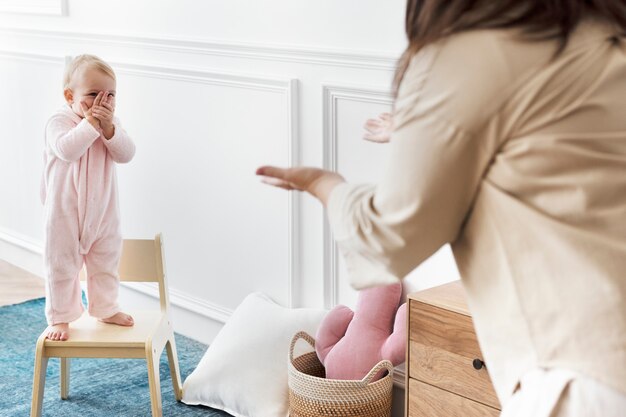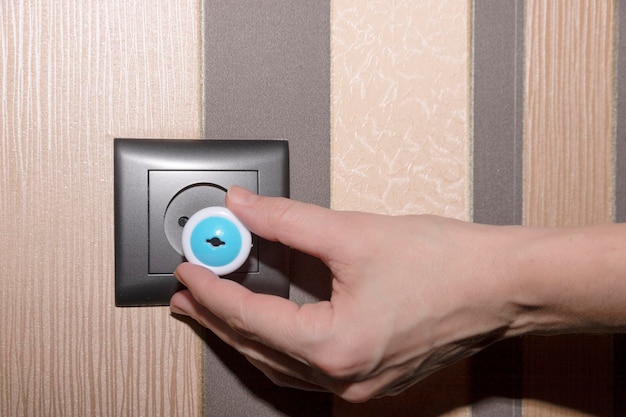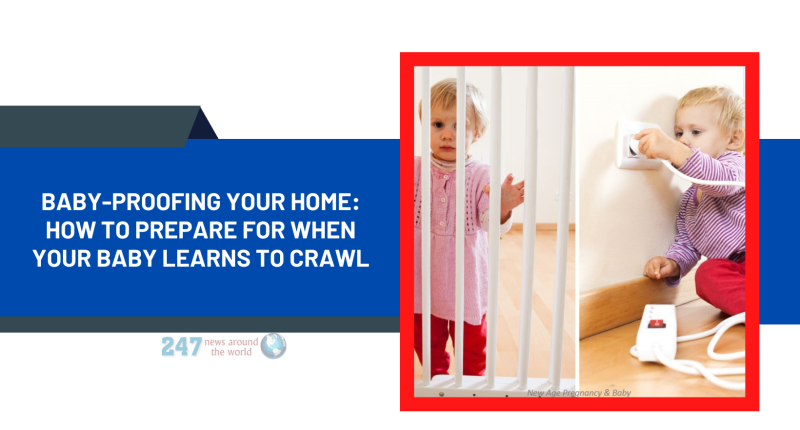As parents, it’s important that we keep our children safe and secure in the home. As they grow older, they start crawling around and exploring their environment. While this is a great milestone in their development, it also means its time to baby-proof your home! In this article, we’ll discuss how to prepare for when your baby learns to crawl by baby-proofing your home.

What is Baby-Proofing?
As your baby starts to become more mobile, it’s important to start thinking about baby-proofing your home. Baby-proofing is all about making your home safe for your little one to explore. This means creating a safe environment for them to move around in, without any hazards that could harm them.
One of the first things you’ll need to do when baby-proofing your home is to assess all the potential hazards. Take a look around your home and identify anything that could pose a risk to your crawling baby. Once you’ve identified the hazards, you can start taking steps to remove or mitigate them.
Some common hazards you’ll want to look out for include:
- Sharp edges on furniture: Make sure that any sharp edges on furniture are well padded or covered so that they don’t pose a risk of cuts or scrapes.
- Small objects: Keep small objects out of reach of your baby, as they can pose a choking hazard.
- Staircases: Block off access to staircases with gates so that your baby can’t attempt to crawl up or down them and hurt themselves.
- Electrical outlets: Cover electrical outlets with child-safe covers so that your baby can’t stick their fingers or other objects into them and risk getting electrocuted.
Once you’ve made your home safe for your crawling baby, you can sit back and relax a little bit! Just remember to keep an eye on them at all times, and to regularly check for any potential hazards that you may have missed.
Safety Hazards Around the Home
There are a number of safety hazards around the home that parents need to be aware of when their baby starts to crawl. These include sharp edges on furniture, small objects that can be swallowed or choked on, and electrical outlets.
It’s important to take the time to childproof your home before your baby starts crawling. This means making sure all sharp edges are covered, small objects are out of reach, and electrical outlets are covered. You may also want to consider getting rid of any poisonous plants or chemicals that could be within reach of your crawling baby.
By taking these precautions, you can help keep your crawling baby safe from harm.
Important Areas to Baby-Proof
Assuming you want tips for baby proofing your home:
When your baby starts to crawl, it’s time to start thinking about baby-proofing your home. Here are some important areas to focus on:
1. The kitchen is a dangerous place for babies and toddlers. Keep all poisonous chemicals and cleaning products out of reach, and install child-safe locks on cabinets. Don’t forget to keep the oven and stovetop off-limits, too.
2. Bathrooms are another hazard zone. Install nonslip mats in the tub and keep toilet lids down at all times. Be sure to store all medicines and vitamins safely out of reach.
3. All electrical outlets should have childproof covers. Keep cords and wires out of sight and reach, too.
4. Windows are a common source of injury for curious kids. Install window guards or stopgap measures like large pieces of furniture in front of windowsills.
5. Stairs are a major tripping hazard for little ones learning to walk. Install gates at the top and bottom of stairs, and never leave your child unattended near a staircase.
Cords & Electrical Outlets

As your baby starts to crawl, they’ll be able to reach new places and touch things they weren’t able to before. This can be a dangerous time if your home isn’t prepared for their new mobility.
One of the most important things you can do to baby-proof your home is to make sure all cords and electrical outlets are out of reach. Keep cords short and tuck them behind furniture so they’re not hanging down where your baby can grab them. Use outlet covers on all exposed outlets, and keep any small appliances unplugged when they’re not in use.
If you have any questions about how to keep your home safe for your crawling baby, talk to your child’s doctor or a certified childproofing specialist.
Kitchen Safety
When your baby starts crawling, it’s time to start baby-proofing your home. Here are some tips for keeping your little one safe in the kitchen:
1. Keep dangerous items out of reach. Store knives, cleaning supplies, and other potentially hazardous materials in a safe place where your baby can’t get to them.
2. Keep an eye on your child at all times. Never leave your baby unattended in the kitchen, even for a moment.
3. child-proofing products can help keep your baby safe. Install cabinet locks to keep curious fingers away from dangerous items, and use safety covers on outlets to prevent electrocution.
4. Teach your child about kitchen safety. As they get older, teach them about the dangers of certain items and how to use them safely.
You may also be interested in: John Fetterman Heart Condition: Did He Undergo Surgery And What Happened To United States Senator?
Bathroom & Laundry Room Safety
Bathroom and laundry room safety is essential for any home with a crawling baby. Here are some tips to help you keep your little one safe in these rooms:
• Keep all cleaning products and medicines out of reach, preferably in a locked cabinet.
• Never leave your baby unattended in the bathroom, even for a moment.
• Keep the toilet lid down at all times to prevent accidental drowning.
• Install child-proof locks on all cabinets and drawers containing potentially hazardous items.
• Always test the water temperature before bathing your baby to avoid scalding.
• Keep laundry detergent and other chemicals well out of reach.
Bedroom & Playroom Safety
As your baby starts to become more mobile, it’s important to take extra care to ensure their safety in your home. Here are some tips for making your bedroom and playroom safe for your little one:
• Remove any loose items from the floor that your baby could trip over or pull down on top of themselves.
• Secure any furniture to the wall using brackets or straps to prevent tipping.
• Place soft pads or rugs around the room to protect against bumps and bruises.
• Keep all sharp objects and choking hazards well out of reach.
• Use Gates or Door Stops to keep baby from accessing areas you don’t want them in.
Staircase Safety
Staircase safety is one of the most important aspects of baby-proofing your home. When your baby starts to crawl, they will be able to explore every nook and cranny of your home, including the staircase.
There are a few things you can do to make sure your staircase is safe for your little one:
1. Install a baby gate at the top and bottom of the staircase. This will prevent your baby from being able to access the stairs without supervision.
2. Keep any cords or wires away from the staircase. Babies are curious and may try to pull on cords or wires, which could cause them to trip and fall down the stairs.
3. Make sure there are no loose tiles or carpeting on the stairs. Loose tiles or carpeting can cause babies to trip and fall, so it’s important to secure them before your baby starts crawling around.
4. Keep stairways clear of toys and other objects. Babies may try to grab onto anything they can reach, which could cause them to lose their balance and fall down the stairs.
5. Always hold your baby’s hand when going up or down stairs. This will help keep them safe and prevent them from falling.
Tips for Making your Home Baby Safe
As your baby starts to become more mobile, it’s important to make sure your home is safe for them. Here are some tips for making your home baby safe:
- Remove any potential hazards from the ground level. This includes things like cords, small objects, and sharp edges.
- Install childproof locks on all doors and cabinets.
- Cover electrical outlets with childproof covers.
- Use safety gates to block off stairs and other dangerous areas.
By taking these precautions, you can help create a safe environment for your crawling baby.
FAQs
1. When should I start baby-proofing my home?
It’s a good idea to start thinking about baby-proofing your home as soon as your little one starts showing interest in exploring their surroundings. This is usually around the time when they start crawling or pulling themselves up to standing.
2. What are some common hazards I need to look out for?
There are many potential hazards in any home, but some of the most common ones to watch out for are sharp corners, loose cords and electrical outlets, small objects that could be swallowed, and poisonous household chemicals.
3. How can I make my home safer for my crawling baby?
There are a number of ways you can make your home safer for your crawling baby. Some simple measures include installing corner guards on sharp furniture edges, tucking away loose cords and removing small objects from reach. You can also child-proof electrical outlets with covers and keep dangerous household chemicals locked away in a safe place.
Conclusion
Preparing your home for when your baby learns to crawl is an important step in creating a safe, secure environment for them. By following the tips outlined above, you can help ensure that your home is properly baby-proofed and ready for their new milestone. Taking the time to make sure everything is set up correctly will create peace of mind and provide a safer space where both you and your little one can feel comfortable.
See Also:
- Eden Polani Parents And Ethnicity: Family And Nationality
- Building Authority and Driving Traffic Through Backlinks
Continue to check our website for more articles of this kind. And, please use our comment section as well, we would love to hear from you.







